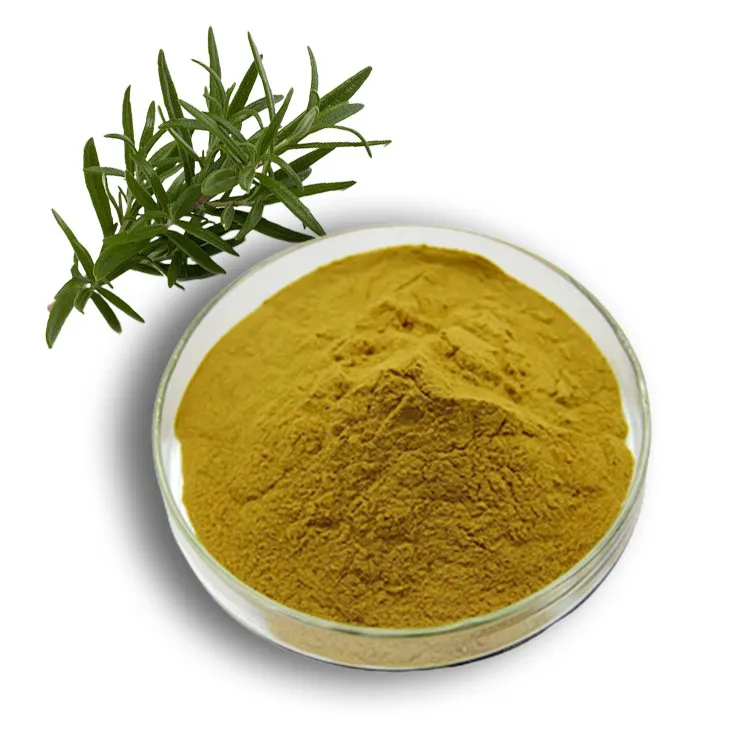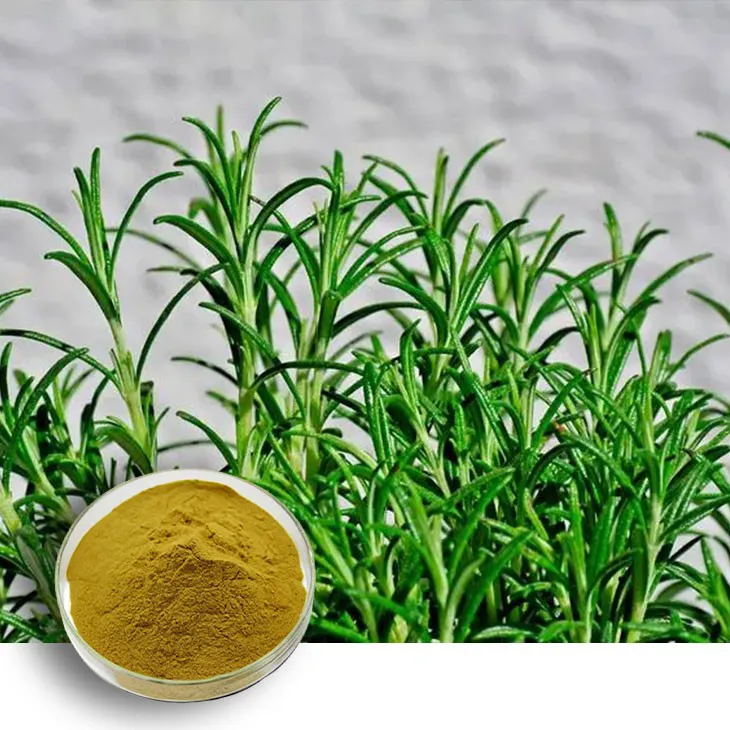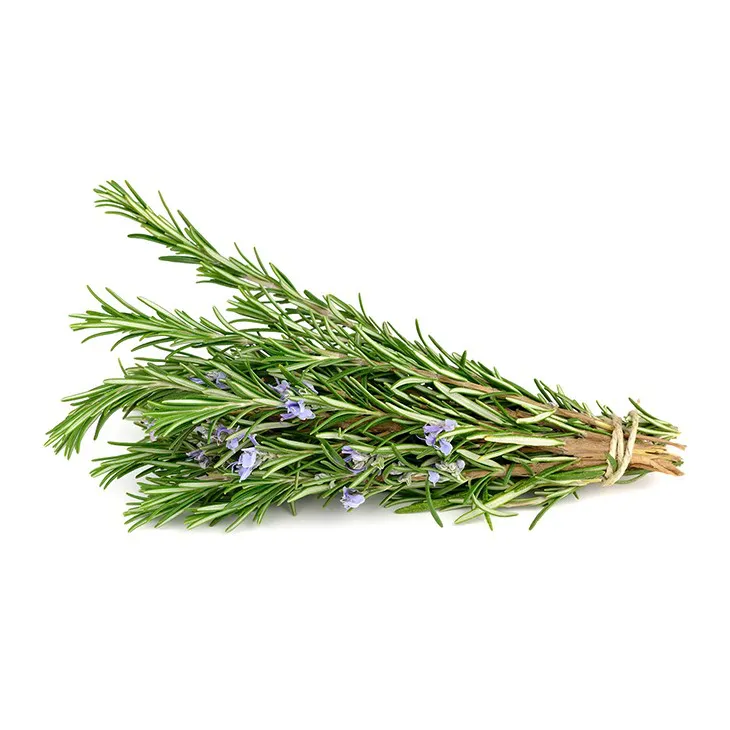- 0086-571-85302990
- sales@greenskybio.com
Organic Supercritical CO2 Extraction of Rosemary Extract.
2024-11-26

1. Introduction
Organic supercritical CO2 extraction of Rosemary extract is a remarkable and cutting - edge technique in the realm of natural product extraction. Rosemary (Rosmarinus officinalis), a perennial herb native to the Mediterranean region, has been highly regarded for its numerous beneficial properties for centuries. It is widely used in various industries, especially in food, cosmetics, and pharmaceuticals.
The extraction of its valuable components has been an area of continuous research. Traditional extraction methods, such as solvent extraction using organic solvents like hexane or ethanol, have certain limitations. These include potential solvent residues in the final product, which may pose safety concerns, especially in applications where the extract is used in food or pharmaceuticals. Moreover, the extraction efficiency and the quality of the extracted compounds may not always be optimal.

2. Supercritical CO2: A Unique Solvent
Supercritical CO2 is a state of carbon dioxide where it exhibits properties that are intermediate between a gas and a liquid. Under specific conditions of temperature and pressure, carbon dioxide can reach its supercritical state. For CO2, the critical temperature is approximately 31.1°C and the critical pressure is about 73.8 bar.
2.1. Properties of Supercritical CO2
In its supercritical state, CO2 has a density similar to that of a liquid, which allows it to dissolve substances like a solvent. At the same time, it has the diffusivity of a gas, which means it can penetrate into the matrix of the rosemary plant material more easily compared to a normal liquid solvent. This unique combination of properties makes supercritical CO2 an excellent choice for extracting bioactive compounds from rosemary.
2.2. Advantages over Traditional Solvents
One of the major advantages of supercritical CO2 is its environmental friendliness. CO2 is a non - toxic and non - flammable gas. It is also readily available and relatively inexpensive. In contrast to traditional organic solvents, which may be hazardous to human health and the environment, supercritical CO2 can be completely removed from the final product without leaving any harmful residues. This is of utmost importance, especially in the food and pharmaceutical industries where purity and safety are crucial requirements.

3. Bioactive Compounds in Rosemary
Rosemary contains a diverse range of bioactive compounds, which are the main targets of extraction. These compounds contribute to the various beneficial effects associated with rosemary.
3.1. Antioxidants
One of the most important groups of bioactive compounds in rosemary is antioxidants. These include phenolic compounds such as rosmarinic acid, carnosic acid, and carnosol. Antioxidants play a vital role in preventing oxidative damage in living organisms. In the food industry, they are used to prevent rancidity of fats and oils, thereby increasing the shelf - life of food products. In cosmetics, antioxidants help in protecting the skin from damage caused by free radicals, which are associated with aging and various skin disorders. In the pharmaceutical field, antioxidants may have potential therapeutic effects in preventing or treating diseases related to oxidative stress, such as neurodegenerative diseases and cancer.
3.2. Other Bioactive Compounds
Besides antioxidants, rosemary also contains volatile oils, which are responsible for its characteristic aroma. These volatile oils have antimicrobial and antifungal properties. Additionally, rosemary contains flavonoids and terpenoids, which may have other biological activities such as anti - inflammatory, analgesic, and anti - diabetic effects.

4. The Process of Supercritical CO2 Extraction
The supercritical CO2 extraction process of Rosemary extract involves several steps.
4.1. Pretreatment of Rosemary
Firstly, the rosemary plant material needs to be properly pretreated. This may include drying the rosemary to reduce its moisture content. The dried rosemary is then usually ground into a fine powder to increase the surface area available for extraction. This step is crucial as it can significantly affect the extraction efficiency.
4.2. Loading the Extraction Vessel
The pretreated rosemary powder is then loaded into the extraction vessel. The extraction vessel is a high - pressure vessel that can withstand the pressures required for supercritical CO2 extraction.
4.3. Introduction of Supercritical CO2
CO2 is then introduced into the extraction vessel. The temperature and pressure are adjusted to bring the CO2 to its supercritical state. The supercritical CO2 then penetrates into the rosemary powder and dissolves the bioactive compounds.
4.4. Separation of the Extract
After the extraction, the supercritical CO2 - extract mixture is passed through a separator. Here, by changing the pressure and/or temperature conditions, the CO2 reverts to its gaseous state and is separated from the Rosemary extract. The separated CO2 can be recycled and reused in the extraction process, which is another advantage of this method in terms of cost - effectiveness and environmental sustainability.

5. Quality of the Rosemary Extract Obtained
The rosemary extract obtained through supercritical CO2 extraction has several notable qualities.
5.1. High - Quality Extraction
This extraction method enables a high - quality extraction of the bioactive compounds from rosemary. Due to the gentle nature of the supercritical CO2 extraction process, the active ingredients are better preserved. This means that the potency and purity of the rosemary extract are maintained at a high level. The extract obtained is rich in the desired bioactive compounds, such as antioxidants, volatile oils, flavonoids, and terpenoids.
5.2. Absence of Residues
As mentioned earlier, since supercritical CO2 can be completely removed from the final product, there are no harmful solvent residues in the rosemary extract. This makes the extract suitable for a wide range of applications, especially those with strict requirements for purity, such as in the food and pharmaceutical industries.
6. Applications of Rosemary Extract in Different Industries
The rosemary extract obtained through supercritical CO2 extraction has diverse applications in various industries.
6.1. Food Industry
In the food industry, rosemary extract is used as a natural antioxidant. It can be added to various food products, such as oils, fats, meat products, and bakery items, to prevent oxidative rancidity and extend their shelf - life. It is also used as a flavoring agent due to its characteristic aroma.
- For example, in the case of olive oil, adding rosemary extract can significantly delay the onset of rancidity, maintaining the quality and taste of the oil for a longer period.
- In meat products, it can act as a preservative while also contributing to the flavor profile.
6.2. Cosmetic Industry
In the cosmetic industry, rosemary extract is valued for its antioxidant and antimicrobial properties. It is used in various skincare products, such as creams, lotions, and serums.
- It helps in protecting the skin from free - radical damage, reducing the signs of aging such as wrinkles and fine lines.
- The antimicrobial properties of rosemary extract can also be beneficial in preventing skin infections and maintaining skin health.
6.3. Pharmaceutical Industry
In the pharmaceutical industry, rosemary extract has potential therapeutic applications. Its antioxidant properties may be useful in the treatment of diseases related to oxidative stress.
- For example, in neurodegenerative diseases like Alzheimer's and Parkinson's, the antioxidants in rosemary extract may help in reducing oxidative damage to neurons.
- It may also have anti - inflammatory and analgesic effects, which could be explored for the development of new drugs.
7. Future Perspectives
The field of organic supercritical CO2 extraction of rosemary extract is still evolving, and there are several potential areas for future development.
7.1. Optimization of the Extraction Process
Research is ongoing to further optimize the extraction process. This includes finding the optimal temperature, pressure, and extraction time to maximize the yield and quality of the rosemary extract. Additionally, the use of co - solvents in combination with supercritical CO2 may be explored to enhance the solubility of certain bioactive compounds.
7.2. New Applications
With the increasing understanding of the bioactive compounds in rosemary, new applications may be discovered. For example, in the field of nutraceuticals, rosemary extract may be developed into more specialized products for health promotion. In the agricultural industry, it may be explored for its potential as a natural pesticide or growth regulator.
7.3. Scale - up and Commercialization
As the demand for natural and high - quality extracts increases, there is a need to scale - up the supercritical CO2 extraction process for commercial production. This requires addressing technical and economic challenges such as equipment cost, energy consumption, and production efficiency.
FAQ:
What are the advantages of organic supercritical CO2 extraction for rosemary extract?
The advantages include being more environmentally friendly as CO2 is non - toxic, non - flammable, and leaves no harmful residues. It also enables high - quality extraction with better preservation of active ingredients, ensuring the potency and purity of the rosemary extract for various applications in the food, cosmetic, and pharmaceutical industries.
Why is supercritical CO2 suitable for extracting rosemary extract?
Supercritical CO2 has unique properties between gas and liquid states under specific conditions. These properties make it suitable for extracting valuable components from rosemary, which contains bioactive compounds like antioxidants.
What bioactive compounds can be extracted from rosemary using this method?
Antioxidants are among the bioactive compounds that can be extracted from rosemary using the organic supercritical CO2 extraction method.
How does this extraction method ensure the quality of rosemary extract?
This method ensures the quality of rosemary extract by better preserving the active ingredients. Since it is a high - quality extraction process, it helps maintain the potency and purity of the extract for different end - uses.
Is organic supercritical CO2 extraction cost - effective for rosemary extract?
The cost - effectiveness of this extraction method for rosemary extract can vary depending on several factors such as the scale of production, equipment costs, and energy consumption. However, considering the high - quality extract obtained and the environmental benefits, it can be a viable option in many cases.
Related literature
- Supercritical Fluid Extraction of Rosemary (Rosmarinus officinalis L.): A Review of Analytical and Preparative Applications"
- "Optimization of Supercritical Carbon Dioxide Extraction of Rosemary (Rosmarinus officinalis L.)"
- "Bioactive Compounds from Rosemary (Rosmarinus officinalis L.) by Supercritical Fluid Extraction"
- ▶ Hesperidin
- ▶ citrus bioflavonoids
- ▶ plant extract
- ▶ lycopene
- ▶ Diosmin
- ▶ Grape seed extract
- ▶ Sea buckthorn Juice Powder
- ▶ Beetroot powder
- ▶ Hops Extract
- ▶ Artichoke Extract
- ▶ Reishi mushroom extract
- ▶ Astaxanthin
- ▶ Green Tea Extract
- ▶ Curcumin Extract
- ▶ Horse Chestnut Extract
- ▶ Other Problems
- ▶ Boswellia Serrata Extract
- ▶ Resveratrol Extract
- ▶ Marigold Extract
- ▶ Grape Leaf Extract
- ▶ blog3
- ▶ blog4
-
Nature's best β - carotene.
2024-11-26
-
Standard - process Coenzyme Q10.
2024-11-26
-
Bulk purchase of pomegranate extract.
2024-11-26
-
Extraction process of bilberry extract.
2024-11-26
-
Manufacturers of Euphrasia Extract.
2024-11-26
-
Chinese peppermint oil powder factories.
2024-11-26
-
Beetroot juice Powder
2024-11-26
-
Cat Claw Extract
2024-11-26
-
Chia Seed Powder
2024-11-26
-
Nutmeg Extract
2024-11-26
-
Green Tea Extract
2024-11-26
-
Citrus Aurantii Extract
2024-11-26
-
Rose Hip Extract
2024-11-26
-
Elderberry Extract
2024-11-26
-
Oat Straw Extract Powder
2024-11-26
-
Angelica sinensis extract
2024-11-26





















